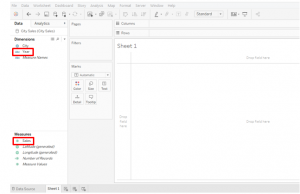

You can then use this pivoted data in the same way as any other Tableau dataset. Once you have written your query, select OK and the data will be pivoted according to your query. SELECT * FROM ( SELECT name FROM table ) AS t PIVOT( MAX(t.name) FOR t.name IN (‘first_name’, ‘last_name’) ) From there, you can write an SQL query that uses the PIVOT function to convert rows into columns.įor example, the following query uses the PIVOT function to convert the “name” column into two columns, “first_name” and “last_name”: To do this, you must first create a connection to your data source and select the “Custom SQL” option from the list of available connections.

Tableau also allows users to write custom SQL queries in order to pivot their data.
#Tableau prep pivot aliases how to
How to Pivot Data in Tableau Using Custom SQL Query Alternatively, you can use the Aggregate function to aggregate data from multiple columns of a pivoted field. For example, you can use the “Join” function to join two pivoted fields together based on their values. Once your data is pivoted, you can use a variety of functions to work with it. This will create a single new field with multiple columns based on the values of your original fields. Additionally, if you want to pivot more than one field, simply hold down the shift key and then drag your fields into the “Pivot” shelf. You can then edit these columns by changing their name or deleting them. This will create a new field with the values of your original field as column names. To do so, select the field you want to pivot and drag it into the “Pivot” shelf. Tableau Prep makes it easy to pivot data in your data set. Rename the pivot fields by clicking on the dropdown next to the field name and click on Rename. Pivot the data by clicking on Transform then click on Pivot. Select the range of fields in the Dimensions/Measures sidebar by holding down Shift and then selecting the first and last field. To pivot data in your worksheet, follow the steps below: 1. It enables you to transform columns into rows and vice versa, as well as perform aggregations on the data. Pivoting data in a worksheet is a great way to reorganize and summarize your data. Rename the Pivot Columns in order to make sense and remove any duplicate columns.Īdd to the pivot by clicking on the dropdown arrow on one of the columns and select Add Data to Pivot. This will pivot your data so that your columns become rows. Select the columns you want to pivot by holding down the Ctrl key and selecting each one individually or by holding Shift.Ĭlick on the dropdown arrow on one of the columns and select Pivot from the dropdown menu. You should see your worksheet on the Data Source tab with all columns and rows. However, here are the basic steps to pivot column values in Tableau: 1. The exact steps for pivoting data in Tableau will depend on the version of Tableau you are using. Additionally, by rearranging datasets into different forms such as columns or rows, users can identify relationships between variables they may not have been aware existed beforehand! How to Pivot Data in Tableau Data Source: Convert Columns to Rows Pivoting data is an invaluable tool for anyone wanting to get more out of their datasets than just surface-level insights – it allows users to explore their datasets from different angles and discover new trends or patterns that could otherwise go unnoticed without being able to rearrange their datasets into various forms such as columns or rows. Reasons You Need to Know How to Pivot Data in Tableau This process allows users to view their data from different angles, making it easier to identify trends or patterns that would otherwise remain undetected. For example, if you have a dataset with two columns (A and B) and four rows (1-4), pivoting the dataset will change the two columns (A and B) into four columns (1-4) with two rows (A and B). Pivoting data is a process that rearranges rows into columns or vice versa. In this blog post, we’ll take a look at what exactly pivoting data is, how to pivot data in Tableau, and why it’s important. By pivoting your data, you can turn rows into columns and access powerful insights into your data that would otherwise remain hidden. Pivoting data in Tableau Desktop can be a tricky process, but it’s an essential skill to master if you want to make the most out of Tableau’s features.


 0 kommentar(er)
0 kommentar(er)
